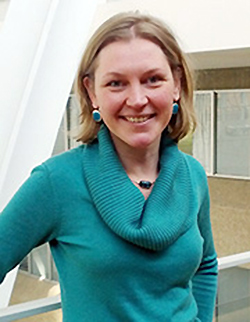
June is Stroke Awareness Month. In the first part of our coverage, read this profile about Dr. Joanna Schaafsma, a new fellow from Holland.
The stroke program at Krembil Neuroscience Centre is working to educate the public on this medical emergency that affects 1 Canadian every 10 minutes. On June 12, join the Krembil Neuroscience Centre's Stroke Program in the atrium of Toronto Western Hospital between 10 a.m. and 2 p.m. to learn about the warning signs of stroke and how to prevent them.
When Dr. Joanna Schaafsma was accepted into a Stroke Fellowship at UHN that combines both clinical work in stroke and research in neuroradiology, she could hardly believe it was possible.
"It's so important to be exposed to clinical work and to have the opportunity to do research. This, to me, is the perfect combination," said Schaafsma, noting that in her native country of Holland, no such integrated stroke program exists.
Schaafsma will begin her two-year Fellowship at the Centre for Neurovascular Diseases & Stroke at the Krembil Neuroscience Centre in July 2014.
In addition to treating patients, she will work with UHN neuroradiologist, Dr. Danny Mandell, to study vessel-wall imaging in young stroke patients.
24-64: Stroke rates will double
Her study comes at a relevant time as a new report recently released by the
Heart and Stoke Foundation predict stroke rates among those aged 24-64 will double in the coming 15 years1.
Dr. Cheryl Jaigobin, a neurologist at UHN's Stroke Program, says investigating vessel wall imaging in this group of young stroke patients will be a world first.
"This group of patients can have different abnormalities in the arteries supplying the brain compared to other patients. Joanna's research will focus on using MRI to identify changes in the walls of arteries of patients under the age of 45," she said.
Dr. Jaigobin says that the research will enable the program to develop a protocol to image arteries in the brain and better identify causes of stroke in this group of patients.
One of the first
The Toronto Western Hospital is one of the first centres where vessel wall imaging technique is being developed.
Led by Dr. Mandell, the level of imaging technique is more advanced compared to other centres in the world.
"In Holland, we apply vessel wall imaging, but predominantly in a preclinical setting," said Schaafsma.
Earlier in the year, Schaafsma completed her residency in neurology at the University Medical Center of Utrecht, The Netherlands, where she developed an interest in stroke and neuro-interventions.
She focused her research on intracranial aneurysms and imaging of aneurysms after endovascular treatment, where, during the 9th Annual Interventional Neuroradiology Symposium in Toronto in 2008, she was introduced to the neuroradiologists from UHN.
As for future aspirations, Dr. Schaafsma would like to work as a stroke neurologist.
One possibility is to return to Holland and, with the knowledge she has gained at UHN, improve practices in logistics and stroke management.
"Patients need to come in the right place with the right doctors and get treatment very quickly," said Schaafsma. "This is very important."
Dr. Schaafsma's Fellowship
at the Centre for Neurovascular Diseases & Stroke was made possible through the support of generous donations made to the
Toronto General & Western Hospital Foundation. The donations have made it possible for two international stroke fellows to study at UHN.
Related Links
